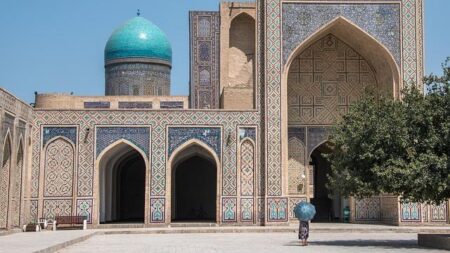In the heart of the Gulf of Guinea lies SĂ£o TomĂ© and PrĂncipe, a picturesque archipelago known for its lush landscapes and vibrant culture. Yet, beneath the idyllic surface, the islands grapple with complex migration dynamics that challenge their socio-economic fabric. A recent installment from the World Bank Blogs, titled “Falling Short: Rethinking Migration in SĂ£o TomĂ© and PrĂncipe,” sheds light on the pressing issues at play as the country contends with rising emigration, brain drain, and the need for comprehensive migration policy. As global migration patterns evolve, SĂ£o TomĂ© and PrĂncipe stands at a crossroads, requiring a strategic reevaluation of its approach to harness the potential of its diaspora while ensuring sustainable development for those who remain. This article delves into the insights provided by the World Bank, highlighting the urgent need for dialogue and action in shaping the future of migration in this enchanting yet vulnerable nation.
Assessing the Economic Impacts of Migration on SĂ£o TomĂ© and PrĂncipe
Migration is a double-edged sword for SĂ£o TomĂ© and PrĂncipe, with profound implications for both the home nation and its diaspora. While many citizens seek opportunities abroad, the outflow of skilled labor is causing a significant brain drain. This loss of talent undermines local industries, leading to a diminished capacity for innovation and economic growth. In turn, this can exacerbate issues like unemployment among the remaining population, particularly youth who are aspiring for better futures. Conversely, remittances from the expatriate community contribute positively to the island nation’s economy, providing a crucial lifeline for many families and helping to boost local consumption.
To comprehend the full spectrum of migration’s economic impacts, it is crucial to consider a few key indicators:
- Remittance Inflows: The amount of money sent back home by migrants, significantly impacting household incomes.
- Labor Market Dynamics: The changes in employment rates and wage levels due to the outmigration of skilled workers.
- Population Growth Rates: The effect of inward versus outward migration on overall demographic trends.
Understanding these factors allows policymakers to better address the challenges posed by migration while capitalizing on its benefits. By formulating strategies to retain talent and nurture the local economy, SĂ£o TomĂ© and PrĂncipe can work towards achieving a balanced approach to migration.
Strategies for Sustainable Migration Policies in Island Nations
Island nations like SĂ£o TomĂ© and PrĂncipe face unique challenges in managing migration effectively, particularly in the face of environmental changes and economic opportunities. To ensure that migration policies are sustainable, it is essential to adopt a multifaceted approach that considers the local context. Key strategies could include:
- Community Engagement: Involving local populations in the decision-making process to ensure migration policies reflect their needs and values.
- Employment Opportunities: Creating job programs that leverage the skills of migrants while supporting local economies, thereby reducing tensions between communities.
- Environmental Awareness: Integrating climate resilience into migration strategies, ensuring that those who are displaced due to environmental factors receive support.
- Regional Cooperation: Collaborating with neighboring islands or countries to create cohesive policies that address shared migration concerns.
Implementing these strategies requires robust data collection and analysis to inform policy decisions. A potential framework for evaluating the effectiveness of migration policies in SĂ£o TomĂ© and PrĂncipe could include the following metrics:
| Metric | Measurement Approach |
|---|---|
| Employment Rate Among Migrants | Surveys and labor market analysis |
| Social Integration Levels | Community feedback and integration surveys |
| Impact of Climate Events | Environmental assessments and migration patterns |
| Capacity of Local Services | Service utilization statistics and resource allocation reviews |
Enhancing Collaboration Between Local Communities and International Partners
Strengthening the ties between local communities and international partners is crucial for effective migration management in SĂ£o TomĂ© and PrĂncipe. Engaging community stakeholders ensures that migration policies address the realities faced by residents and promotes inclusive development. To foster these collaborative efforts, it is essential to prioritize the following strategies:
- Stakeholder Workshops: Organize regular workshops that bring together local leaders, community members, and international organizations to discuss migration challenges and opportunities.
- Knowledge Sharing Platforms: Create online platforms where best practices and success stories can be shared, bridging the gap between local experiences and global expertise.
- Capacity Building: Provide training programs for local organizations to enhance their skills in negotiating and collaborating with international partners.
Additionally, establishing a framework for continuous dialogue can significantly enhance mutual understanding. A proposed model is illustrated in the following table, which outlines key components for effective community-partner engagement:
| Component | Description |
|---|---|
| Regular Forums | Monthly meetings to discuss ongoing projects and gather feedback from community members. |
| Joint Projects | Collaborative initiatives that leverage local knowledge alongside international resources. |
| Evaluation Metrics | Measurable goals set in partnership to assess the impact of collaborative efforts. |
The Way Forward
As SĂ£o TomĂ© and PrĂncipe grapples with the intricacies of migration, the insights from the World Bank highlight the urgent need for a holistic approach that prioritizes sustainability, inclusivity, and economic resilience. While the challenges are significant, they also present a unique opportunity for stakeholders-from government officials to local communities-to rethink migration policies that can better serve both the migrants and the nation as a whole.
It is clear that the current strategies are falling short. The World Bank’s call to action emphasizes that by embracing a comprehensive framework for migration, SĂ£o TomĂ© and PrĂncipe can not only mitigate the pressures of emigration but also harness the potential of migrants as contributors to the nation’s development.
As the dialogue continues, it is crucial for policymakers to listen to the voices of those affected and consider innovative solutions that promote social cohesion and economic growth. The future of migration in SĂ£o TomĂ© and PrĂncipe demands collaborative efforts and forward-thinking initiatives to ensure that the small island nation can thrive in a rapidly changing global landscape. The time for action is now-it’s a call to all stakeholders to unite and redefine the narrative of migration within this vibrant society.







